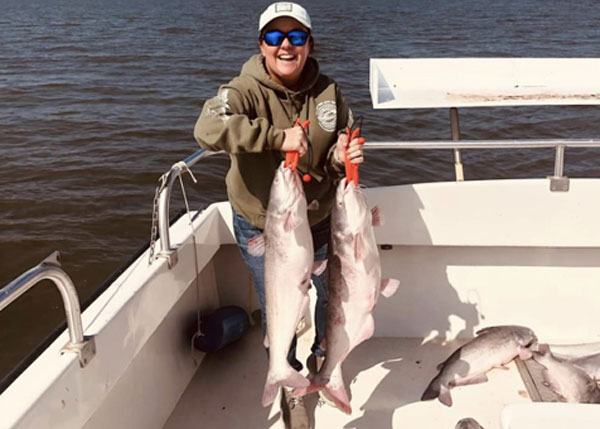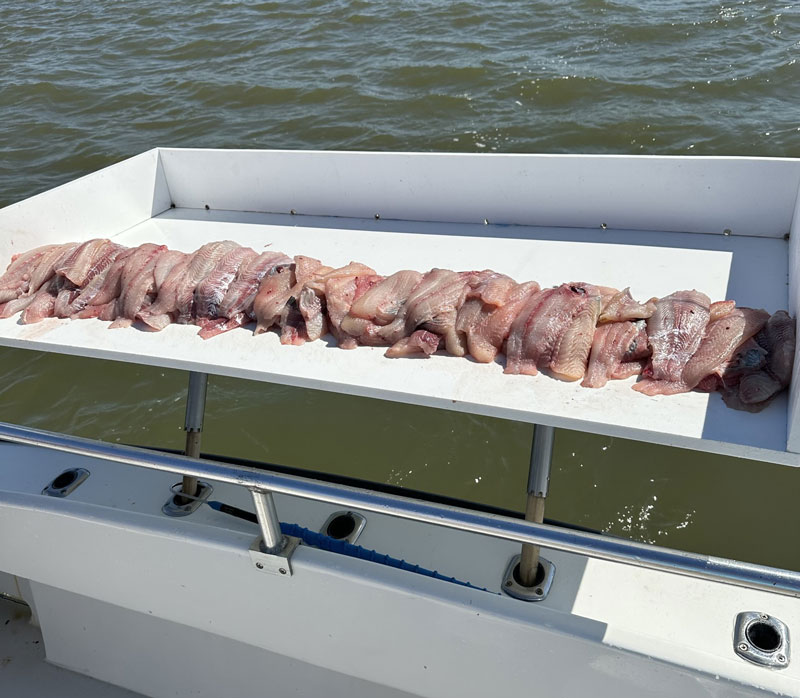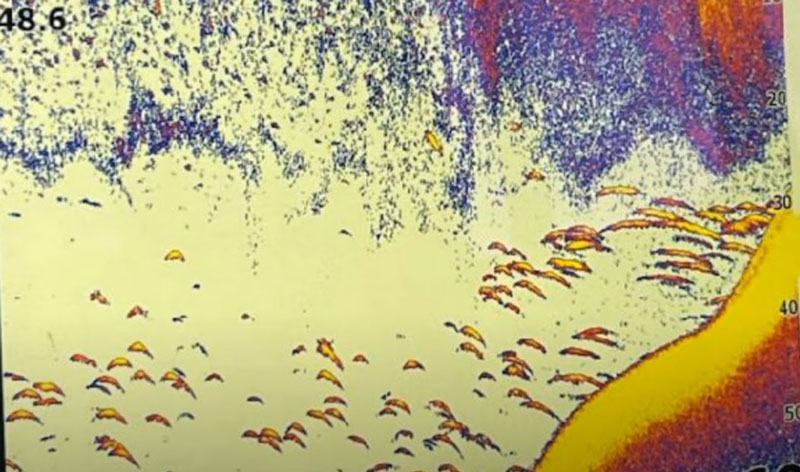Captain Marcus gets the anchor set and his mate Tommy starts tossing out lines one after the next, but before the fourth one flies over the side a rod starts bending and the reel starts singing. As that first blue catfish is brought up to the net another rod goes down and seconds later, a third. What began as a promising day of fishing for blue catfish near the 301 Bridge on the Potomac River morphs into a speed-baiting contest, an all-hands-on-deck race to thread chunks of bunker and mud shad onto hooks then re-deploy the line as fast as possible. There are few breaks in the action, those breaks are exceptionally short, and it’s more common to have two or three fish on at a time than it is to get a single bite. Check out the action:
Be forewarned: if you like slow-paced fishing where you stare at unmoving rod tips for hours on end, this isn’t the sort of fishery for you. But if you crave constant action, then schedule a fishing trip for blue catfish on the Potomac this spring.
Blue Catfish Boom
We fished with Hot Lick Charters (301-785-1199 or [email protected]), running out of Goose Bay Marina in Welcome, MD, at the beginning of March last spring. This is a new fishery that charters are just beginning to tap into, but from our experience it was quite obvious that they’d already figured it out. Despite blustery winds and a cold front that pushed through midday, we stacked dozens and dozens of 22” to 28” blue cats in the fishbox.

Why keep so many fish, when we anglers often preach catch-and-release? As most Bay-lovers know, blue catfish are an invasive species which has undergone an epic population explosion in recent years. That may make for fast fishing, but it also introduces a new level of competition and predation to our native species. The exact impact is tough to assess, but just about all the biologists studying the Bay recognize that the blue catfish’s sudden and extreme dominance is having a dramatic impact on striped bass, white perch, yellow perch, and other species that have called the Bay home for a millennium. Thus, there are no limits or restrictions on blue catfish in the Potomac and the authorities encourage anglers to keep all that they can.
Added bonus: blue catfish in this size range are excellent table fare and don’t carry the same consumption advisories as fish over 30 inches (see Potomac fish consumption advisory to see the full listings for all species). They have a firm white meat that’s unlike other catfish, and they freeze well when vacuum bagged. The bottom line? Blue cats are an ideal target for anglers who like to eat fish and enjoy loading the boat from time to time, but are also conscientious of the impact their catch can have on the environment. By keeping these fish you don’t just avoid overharvesting a sensitive species, you’re actually doing the Bay’s ecosystems a solid.

Blue Cat Brass Tacks
The “how” part of the blue catfish fishing equation is about as straightforward as it gets. As we mentioned, charters have moved into this fishery, so naturally the easiest way to learn the ropes is to jump on one for a day and see how it’s done. The added advantage to this move is that you can get on a large boat with a heated cabin, which is exceptionally nice during the early spring run when chilly temperatures and strong winds are common. But if you have a boat that isn’t currently winterized, plenty of warm clothes, and the gumption to give it a go on your own, you won’t have a difficult time putting the pieces together.
- Rods and Reels: 6’6” to 7’0” medium-weight rods in the 15- to 20-pound class, with spinning or conventional reels. Baitrunners or reels that can be set in freespool with the clicker on are even better, since you can leave them in the rod holders but still give the fish time to eat before applying full pressure.
- Terminal Tackle and Rigs: Slide an egg sinker onto your mainline or rig your mainline through a fishfinder, and tie on a swivel. Then clip on three to four feet of 30- to 50-pound test leader, capped off with an 8/0 to 10/0 circle hook. Use a range of weight sizes (one to three ounces will get the job done) on different lines so you can stagger them at different distances from the boat when the current is running.
- Bait: These fish will eat just about anything, but it’s tough to beat bunker chunks. Many Virginia anglers tend to favor cut mud shad. Chicken breast, chicken liver, and just about any other cut fish will work as well.
Fan-cast your lines out around the boat and allow the weight to hit bottom. Then simply wait for the rod to bend over and the line to run out. Don’t leap for the rod when it gets a bite but instead allow the fish to eat for three to five seconds before picking up the rod, applying pressure, and reeling it to the boat. And of course remember: no hook-sets with circle hooks.

The “where” part is just as straightforward. Channel edges are the ticket, and abrupt depth changes ranging from 10 to 30-plus feet of water are likely to hold fish. Those adjacent to bends in the channel or points protruding into it are ideal. These aren’t difficult to find in the Potomac and a quick scan of the charts will provide you with plenty of options.
Blue catfish show up clearly in the meter, so when you get where you’re going a couple quick passes back and forth over the edge should make it clear what depth range the fish are staging at on any given day. Note: despite their reputation these fish don’t just park themselves on the bottom and sit there. When you see bunches of fish eight or 10 feet off bottom don’t dismiss them as something else merely because they’re suspended, as they may well be the very blue cats you’re after.

Your biggest challenge will likely be anchoring up such that your boat and your baits sit right along the drop-off. If you have a trolling motor with Spot-Lock you’re in luck, since pinpoint position “anchoring” is about as easy as it gets and making adjustments to your position is a button-press away. Either way, should you end up sitting too shallow or too deep it’s worth the extra effort and time to re-set the boat, multiple times if necessary, until you’re in the ideal depth range — this can make the difference between getting a bite every five minutes or getting five bites a minute.
Do you enjoy sipping a beverage and lounging around as you wait for a strike? Are you the type of angler who goes out on the water to kick back and relax? Is it a relief when you come home with an empty fishbox that doesn’t need any cleaning? If you answer “yes” to any of these questions, then you’d best stay far, far away from the Potomac River this spring. But if you’re up for fast-action angling action that will be challenging to keep pace with, this is one fishery that’s tough to beat.
Trot Line Alert:
When choosing a spot to fish look out for pairs of large floats or jugs up to 1200 feet apart, which are marking each end of commercial trot-lines set out for blue cats. There are many in the Potomac and snagging commercial gear will be problematic for everyone involved.
Blue Catfish Recipes
You say you’re not so sure about stacking blue catfish fillets in the freezer? Try one of these recipes and we’ll bet that attitude changes fast.
Blue Catfish Fish Tacos
Ingredients:
- Blue catfish fillets (chilled)
- Blackening season
- Butter
- Chimichurri sauce
- Coleslaw with red cabbage
- Corn Salsa
- Tortillas or taco shells
- Melt the butter (about a quarter stick per four hand-sized fillets), then mix in a healthy scoop of blackening season.
- Coat the chilled fillets with the butter/season mix and allow a minute or two for it to harden. Then flip them onto a piece of wax paper and coat the other side.
- Bring a pan up to a high heat, then drop in the fillets. You want it hot enough that the butter burns and blackens the moment you drop in the fish. Cook the fillets for about two minutes then flip them to blacken the other side.
- Put the blackened fillets on a plate and use a fork to break them into bite-sized pieces. Load up your tortillas or shells, toss on a layer of corn salsa and a pile of slaw, followed by some Chimichurri sauce. YUM!
Blue Catfish Cakes
Ingredients:
- Blue catfish fillets
- Bread or Panko crumbs
- Egg
- Mayonnaise
- Old Bay
- Old Bay hot sauce (optional)
- Worcestershire Sauce
Steam or poach the fish, allow it to drain, then break the fillets apart in a large bowl. Add in (per pound of fish) a quarter cup of bread or Panko crumbs, one egg, two tablespoons of mayo, and a couple dashes of Worcestershire sauce. Add Old Bay and hot sauce in amounts appropriate to your taste. Mix thoroughly, form into cakes, then fry in hot oil until golden brown.
For more blue catfish recipes, check out the Maryland's Best Blue Catfish webpage.
Editor's note: We send out a special thanks to Capt. Marcus Wilson of Hot Lick Charters for bringing us out to this red-hot-lick fishery last spring. Not only was the bite on fire, Marcus and Tommy were a total pleasure to fish with. You’ll find Marcus fishing along with Capt. Robin Payne on the Rock-n-Robin, and can contact him at (301) 785-1199 or via [email protected].